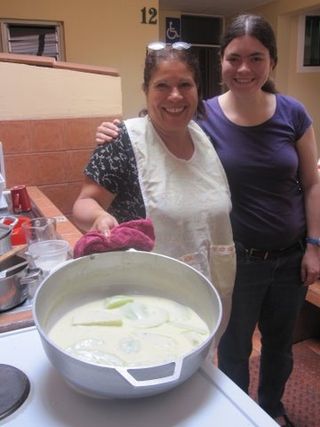 By Jennie M., guest blogger studying Spanish in Heredia, Costa Rica
By Jennie M., guest blogger studying Spanish in Heredia, Costa Rica
Since my Mama Tica is also the cooking teacher at school, I have had a variety of delicious meals. At home, she doesn't always cook comida tipica. I have had everything from spaghetti with marinara sauce to the traditional gallo pinto. Rice and beans are a common staple of Costa Rican food. For lunch, I often go to a local soda – a small restaurant – for a casado. A casado often includes rice, beans, meat (or cheese if you prefer), with vegetables. Platanos (or plantains) are a common side. One of the first lessons I learned with food in the markets was not to confuse platanos with bananas, as they look quite similar. In Costa Rica, bananas are smaller.
No matter where you choose to study, I highly recommend taking advantage of the extracurricular activities that your school offers. Extracurricular activities are a great way to get integrated into the school and the culture of your host country. They are also a great way to learn the language in a different context. I always look forward to both the cooking class and dance classes each week.
For the cooking classes at school, I have had the opportunity to sample additional delicious Costa Rican dishes. The teacher always begins by handing out recetas – recipes – for that week's meal, which include a list of helpful vocabulary words, from ingredients to cooking utensils.
During one of the Wednesday cooking classes, I helped make Chayotitos a la Crema. Chayotes are vegetables that look somewhat like a green squished baseball in their raw form (see market picture). The other ingredients: Flour (harina), butter (mantequilla), garlic (ajo), 1 onion (cebolla), 2  egg yolks (yemas de huevo). The final result, after much peeling, cutting, and cooking, was absolutely delicious when served with rice.
egg yolks (yemas de huevo). The final result, after much peeling, cutting, and cooking, was absolutely delicious when served with rice.
It's one thing to go to the various restaurants in Heredia, but another completely to taste some of the delicious home cooked meals of Costa Rica. Exploring the food of another country can be one of the richest parts of your study abroad experience. I encourage you to go out and explore the markets and bakeries, and sample foods you've never heard of. You may be pleasantly surprised.
Picture 1: Fruits and Vegetables at street market
Picture 2: Me with Jeannette, the cooking teacher at school
Learn more about studying Spanish in Costa Rica
Read all of Jennie's blogs from Heredia



 ShareThis
ShareThis
